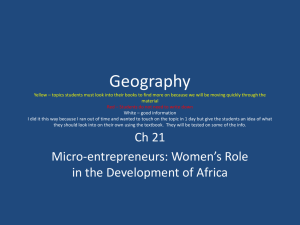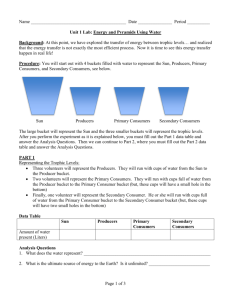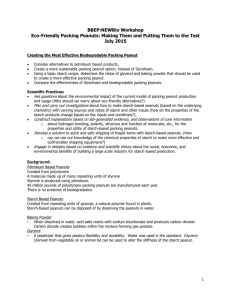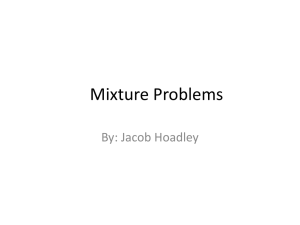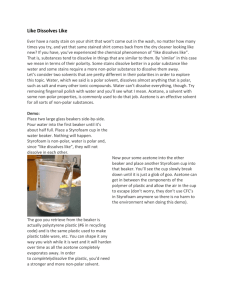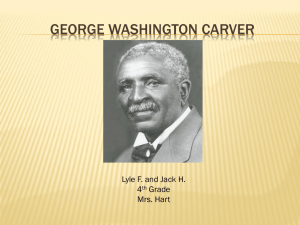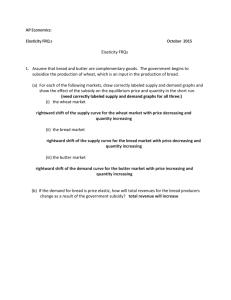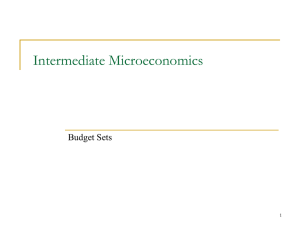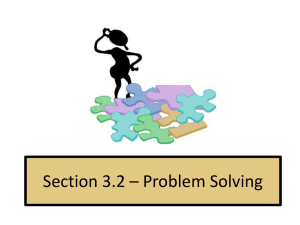Poll Sol - Teacher N..
advertisement
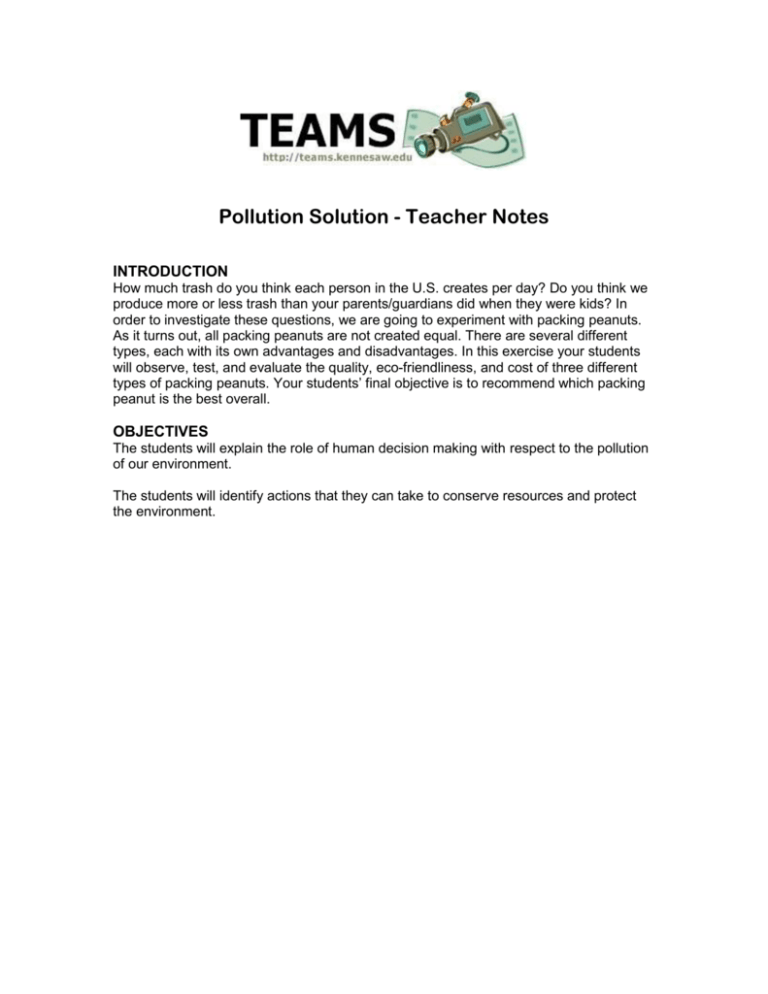
Pollution Solution - Teacher Notes INTRODUCTION How much trash do you think each person in the U.S. creates per day? Do you think we produce more or less trash than your parents/guardians did when they were kids? In order to investigate these questions, we are going to experiment with packing peanuts. As it turns out, all packing peanuts are not created equal. There are several different types, each with its own advantages and disadvantages. In this exercise your students will observe, test, and evaluate the quality, eco-friendliness, and cost of three different types of packing peanuts. Your students’ final objective is to recommend which packing peanut is the best overall. OBJECTIVES The students will explain the role of human decision making with respect to the pollution of our environment. The students will identify actions that they can take to conserve resources and protect the environment. SCIENCE STANDARDS National Science Standard: Unifying Concept Nature is composed of many interrelated systems. Georgia Performance Standards: Students will use tools and instruments for observing and measuring S(K-5)CS3 Students will communicate scientific ideas clearly S(K-5)CS5 Students will understand the effects of pollution on the environment S3L2 SCIENCE REFRESHER In this exercise, students will design and conduct tests to evaluate the protective capabilities, environmental friendliness, and cost of different types of packing peanuts. Acting as a fictional company, each student group will then synthesize their results in these categories and arrive at a conclusion as to which type of peanut to purchase. Experimental Design and Critical Analysis This exercise has students conduct a number of activities that strengthen scientific thinking skills. First, they must design a series of tests, or experiments, by which they evaluate the protective capabilities of different types of packing peanuts. This provides an opportunity to practice designing rigorous experiments. The activity goes a step further, however, in having students consider the environmental impacts and cost of the different types of packing peanuts when choosing which type of peanut to purchase. This promotes environmental awareness by training students to consider the environmental impacts of their everyday decisions, a skill which will hopefully persist throughout life. By considering cost, the exercise gains added realism, as this is an important variable in any business decision. By working in groups, students will see that not everyone shares their views on which variables (protection, impact, and cost) are the most important, and they gain practice working collaboratively to arrive at a consensus opinion. The Environmental Issue: Solid Waste Pollution Solution provides an opportunity for teachers to investigate an important environmental issue in the modern world – solid waste disposal. Conventional packing peanuts are made of a plastic called Styrofoam (its actual name is polystyrene) and are often discarded into the trash after a single use. Other packing peanuts are created from cornstarch, which will quickly dissolve (biodegrade) when exposed to water (Figure 1). Both of these types of peanuts are polymers – long chains of repeating molecules. Styrofoam is synthetic plastic polymer while cornstarch is a natural polymer of glucose molecules – sugar – and so will breakdown in water. These cornstarch peanuts are quite popular and increasing in use as many companies seek to reduce their environmental impacts. Cornstarch peanuts can be washed down the drain or thrown onto the ground for disposal, unlike the Styrofoam peanuts which end up in the “stream” of household and business waste requiring disposal. An estimated 200 million cubic ft (5.6 million cubic m) (the volume of a box 1 foot tall, 1 foot wide, and 1 foot deep) of Styrofoam packing peanuts are used in the United States each year, so we’re talking about a lot of material. In 2003, the United States generated 472 million lbs (214 million kg) of municipal solid waste, around 1600 lbs (725 kg) per person, the breakdown of which is provided in Figure 2. The “high consumption” modern lifestyle creates a great deal of waste, and the U.S. and other wealthy nations generated 50% of the world’s solid waste in 2003 despite having only 20% of the world’s population. The amount of wastes generated per person is climbing all over the world, however, and we all need to reduce our waste generation if we are to live sustainably on Earth. The material in the “solid waste stream” experiences one of three fates in modern America – landfilling (56%), incineration (11%), or recycling (32%). Figure 1. Cornstarch peanuts (left), dyed cornstarch peanuts (Magic Nuudles - middle), and Styrofoam peanuts (right). Figure 2. Materials in the U.S. waste stream in 2000. [http://www.epa.gov/epaoswer/non-hw/muncpl/facts.htm] Landfilling A modern, sanitary landfill is designed to minimize the pollution of groundwater with material leaching from the interred garbage (Figure 3). The landfill begins with a large depression in the ground that is then lined with several feet of clay (through which water flows poorly) and covered with a plastic liner to collect liquids. Solid wastes are then piled on top of the liner and covered daily with ash (from power plants) or soil to suppress odors and pests. Once the landfill has reached its maximum capacity, it is covered with several feet of clay and the site vegetated with grass, shrubs, and trees to help it blend into the landscape. Contrary to popular belief, material in landfills actually decomposes poorly because it is kept dry and away from oxygen – two things that promote decomposition. For example, scientists excavating landfills from the 1920s have found readable newspapers, grass clippings, and partially-eaten donuts. But despite these precautions, groundwater can sometimes be contaminated with harmful substances that leach out of landfills. This renders the water unusable for drinking or irrigating crops and costs sizable amounts of money to treat. Groundwater contamination is generally more severe in poorer nations, where government regulations regarding landfill construction are not as strict as in the United States. The decomposition that does occur within landfills can also generate methane, which acts a greenhouse gas and traps heat in the atmosphere. Cutting the amount of waste we generate could therefore reduce the land disturbed for landfill construction, lower groundwater pollution levels, and slow the process of global warming. Figure 3. A modern sanitary landfill. [http://www.metrokc.gov/dnr/kidsweb/images/landfill_diagram.gif] Incineration Another method of disposal is incineration, where wastes are burned to reduce their volume and generate energy. Metals and other non-flammable materials are separated from wastes, which are then shredded and burned in large incinerators. The heat produced by combustion is often used to generate electricity. The ashes left after combustion have only 10% of the volume of the original wastes, but must be regularly tested for the presence of toxic compounds. Solid waste incinerators are required by U.S. law to use extensive pollutioncontrol mechanisms, but air emissions from incinerators can still contain several highlydangerous chemicals. Pollution released by incinerators can be higher in poorer nations where government regulations are less strict. Incineration is used less than landfilling due to its higher costs and public concerns about incinerators operating in their local area. Generating fewer wastes leads to less need for incineration and reduced levels of air pollution. Recycling The final fate for solid wastes is recycling, where material is removed from the waste stream and formed into new products. The growth of recycling in the United States is one of the greatest environmental successes of the last 40 years. In 1960, only 6.3% of the waste stream was recovered through recycling. By 2005, over 32% of the waste stream was recovered through recycling (Figure 4). This improvement has been attributed to environmental education, the initiation of curbside recycling programs that make recycling convenient, and by “bottle bill” laws in some states that put a refundable deposit on beverage containers. Figure 4. Recycling rates in the U.S. from 1960-2005. [http://www.epa.gov/epaoswer/non-hw/muncpl/facts.htm] Approaches to improvement We generate more wastes now than we did in the past. In 1960, the average American put 2.7 lbs (1.2 kg) of material into the waste stream each day. By 2003, it had risen to 4.5 lbs (2.0 kg) per person per day. Higher rates of recycling have kept some of this added material out of landfills and incinerators, but what can we do to generate less waste in the first place? The “3 R’s” – reduce, reuse, and recycle – are the most commonly proposed approach. Reduce means generating less waste through source reduction. Some ways to reduce wastes include purchasing products with little or no packaging, buying music digitally online instead of on CD, reading the online version of the newspaper instead of the printed version, and composting biodegradable food wastes and grass clippings into compost instead of placing them in the garbage. Some elementary schools sponsor “waste-free lunch days” where students bringing their lunch strive to produce as little waste as possible by using reusable containers and silverware, eating all the food they bring, and so on. Reuse means using material as long as possible to delay its entry into the waste stream. Reuse paper that is only printed on one side. Donate used but still functional items to charitable organizations for sale and reuse, and purchase used items whenever you can. Recycle everything you can. Newspaper, office paper, metal food cans, aluminum beverage cans, glass containers, plastic milk jugs – they can all be collected and turned into new products. This saves the material from disposal and conserves huge amounts of energy, as creating a new product from recycled material takes only a fraction of the energy of creating that product from virgin materials. Even batteries and electronic equipment can be recycled in many towns and cities – call your local sanitation department to see if such programs are available in your area. By focusing on one component of the waste stream, packing peanuts, this exercise can introduce students to larger issues such as solid waste management. In so doing, it can show students how their individual lifestyle decisions have broad implications for the world around us and help promote environmental introspection in students. MATERIALS Pollution Solution Activity: Cornstarch Packing Peanuts Styrofoam Packing Peanuts Colored Cornstarch Peanuts (Magic Nuudles) Clear Plastic Cups Paper or Plastic Cups Available at Most Office Supply Stores and online outlets. 5 per student group. Available at Most Office Supply Stores. 5 per student group. Available at School Supply Stores and online outlets. 5 per student group. Common type are “Magic Nuudles” brand. 3 per student group. Used to hold packing peanuts. 3 per student group. Fill with water and test if peanuts can dissolve. Extension Activity: Assorted Art Supplies Stopwatches or timers Thermometers Used to create promotional materials for their chosen packing peanut. For measuring time needed for cornstarch peanuts to dissolve in water of differing temperature. For determining water temperatures EXPLORATION (Teacher-led): Preparation This activity places students in the role of owners of a mail-order business, forced to make a decision concerning the type of packing peanut they will use to ship their products. Students will be provided several types of peanuts and design tests to evaluate their ability to protect products. They will then consider the environmental impact and cost of each type of peanut, weigh these factors, and decide which peanut to use. Procedure 1. Give each group of students five peanuts of each type. Ask students to explore the properties of the peanuts in a variety of different ways. They can touch, squeeze, pull, smell, measure, and listen to the peanuts – but no tasting please. Have students write down their observations on the table in the student handout. 2. Each student group will develop a simple method to test their peanuts for protection of product in shipping containers. Students describe the test on their activity sheet, conduct their analyses, and record results. 3. After consideration of protective qualities, students are asked to evaluate each type of packing peanut with respect to environmental impact. Are the peanuts biodegradable? Students can attempt to dissolve each in water to answer this question. 4. Students now synthesize each peanut’s protective qualities, its environmental impacts, and cost and make a conclusion as to the type of peanut their fictional business would embrace. They will list their choice and provide a brief explanation for it on the student activity sheet. 5. Students reflect on their lifestyle and list three ways to reduce their personal generation of garbage on the student activity sheet. Additional Resources – Packing Peanut Activities www.ipse.psu.edu/activities/polymers/packingpeanuts_activity.doc This document from Internships in Public Science Education at The Pennsylvania State University describes how to make your own cornstarch packing peanuts and describes how to test the protective capabilities of cornstarch and Styrofoam peanuts using an egg drop experiment. Essential Questions 1. For something to make for a good packaging material, what other characteristics must it have in addition to its ability to protect? 2. Although it may be good to have peanuts that are bio-degradable, describe one situation where this could be a problem. 3. Since each of us produces over 4 pounds of trash per day, decide on three things that you could do to reduce the amount of trash you produce. 4. Do you think we should require companies to use eco-friendly packing peanuts by law? Explain. Safety and Disposal The biodegradable peanuts are typically non-toxic, but students should not be allowed to taste or ingest them. Peanuts dissolved in water can be rinsed down the drain with copious amounts of water. Additional Resources – Dissolving Styrofoam Peanuts http://www.stevespanglerscience.com/experiment/00000046 This activity from Steve Spangler Science describes how to use acetone (nail polish remover) to dissolve Styrofoam peanuts. Watch the provided video to see an interesting way to use this as an inquiry science activity for your students. If you conduct such an exercise, it should be done outside or in a well ventilated area. The handling of acetone should also be done by the teacher alone. Explanation (Concept Building) Environmental issues provide great opportunities for kids to explore problems that they experience in their home communities. We’ve seen the large amounts of waste generated by each person and examined ways to reduce it. Styrofoam packing peanuts are an example of an “unseen” waste source and so are an appropriate subject for this exercise. Despite the fact that Americans recycle 46% or their plastic soda bottles and 30% of their milk and water jugs, we only recycle 5% of all plastics! This is due to the fact that 40% of all plastics are used in packaging and little of this is recycled. Extension Activities: (1.) Communicating ideas Student groups are asked to create promotional materials for their chosen packing peanuts with posters, brochures, bumper stickers, commercials, or other creative outlets. The materials produced are shared with the class and the differing approaches embraced by each group are explained. (2.) Incorporating Mathematics Have students answer the question “do cornstarch peanuts dissolve differently in warm and cold water?”. Fill individual containers with either warm, room temperature, or cooled water. Measure and record the temperature of the water with a thermometer. Add a standard amount of cornstarch peanuts to each container. Start a timer and observe at regular increments the degree to which the peanuts have dissolved. Stop the timer when the peanut has completely dissolved and graph the differences in the three temperatures. Promote inquiry by allowing students to design the experiment and determine proper methods for data presentation.
